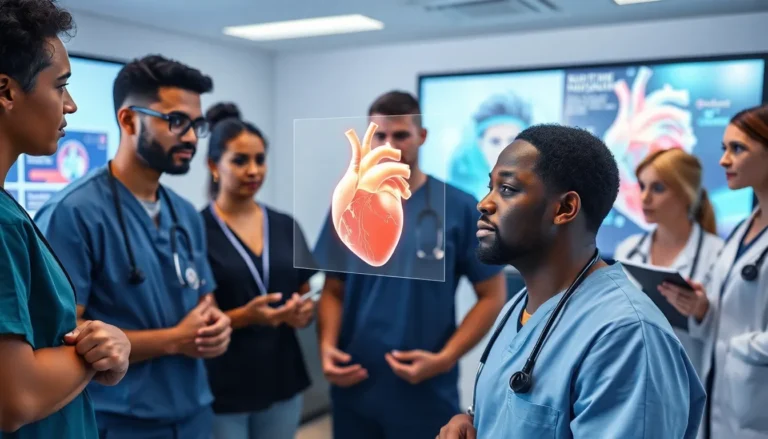Table of Contents
ToggleImagine a world where surgeons don’t just rely on their trusty scalpels and intuition, but also on a high-tech pair of virtual glasses. Welcome to the realm of augmented reality surgery, where the operating room transforms into a digital wonderland. With the help of this cutting-edge technology, doctors can overlay critical information directly onto a patient’s anatomy, making complex procedures feel like a game of operation—minus the buzzing sound when you touch the sides.
This innovative approach not only boosts precision but also enhances collaboration among medical teams. It’s like giving every surgeon a superhero cape, allowing them to see beyond the skin and into the very heart of the matter. As augmented reality continues to evolve, it promises to revolutionize the way surgeries are performed, making them safer, faster, and maybe even a little more fun. Who knew saving lives could come with a side of high-tech flair?
Overview of Augmented Reality Surgery
Augmented reality surgery represents a significant advancement in medical technology. Surgeons gain access to real-time, detailed overlays of patient anatomy through the use of specialized virtual glasses. This technology enhances visualization, allowing for more precise movements during complex procedures. Surgeons can view critical information, such as imaging data or anatomical landmarks, directly integrated into their field of vision.
Integration of augmented reality in the operating room supports improved teamwork among medical professionals. Team members can share insights or modifications in real-time, leading to a more collaborative surgical environment. Enhanced communication helps ensure surgical accuracy and efficacy.
Various studies highlight the positive impact of augmented reality on surgical outcomes. Research indicates that the technology reduces operation time by up to 25%. Increased precision decreases the likelihood of complications, enhancing patient safety.
Incorporation of augmented reality extends beyond initial surgical applications. Ongoing research continues to explore its usage in surgical training and education. Trainees benefit from hands-on experiences augmented by digital visualizations, improving learning processes in surgical techniques.
The future of augmented reality surgery suggests even greater innovations. As technology evolves, additional features may include artificial intelligence integration for predictive analytics. Such advancements could lead to personalized surgical approaches based on individual patient data.
Healthcare professionals stand at the forefront of this technological revolution. Augmented reality surgery positions itself as a vital tool in modern healthcare, promising to reshape the surgical landscape.
Benefits of Augmented Reality Surgery

Augmented reality surgery offers a range of advantages that enhance surgical procedures. Key benefits include improved visualization and greater precision during operations.
Enhanced Visualization
Surgeons experience a significant boost in visualization capabilities. Augmented reality overlays critical patient data onto the surgical site. This technology allows for a 3D representation of complex anatomical structures. Medical professionals often access crucial information without diverting their focus from the patient. Enhanced visualization aids in identifying crucial nerves and blood vessels, minimizing the risk of damage. Some studies show that this clear imaging can improve surgical planning and reduce reliance on traditional imaging techniques. As a result, surgeons position themselves for success with a clearer understanding of anatomical relationships.
Improved Precision
Surgeons realize improved precision with augmented reality tools. This technology facilitates precise instrument positioning during delicate procedures. The use of real-time feedback enhances the accuracy of surgical movements. Surgeons often report increased confidence in their techniques thanks to augmented guidance. Research indicates that the integration of augmented reality can reduce operation time by as much as 25%. Less time in the operating room correlates with decreased patient risk and potential complications. Additionally, improved precision leads to better surgical outcomes, contributing to enhanced patient safety and satisfaction.
Challenges in Implementing Augmented Reality Surgery
Augmented reality surgery faces several challenges that can hinder its effective implementation. Understanding these obstacles helps in navigating the complexities of this innovative technology.
Technical Limitations
Technical limitations pose significant challenges. Hardware must deliver high-resolution graphics to ensure accurate overlays of anatomy. Software also needs to be compatible with various surgical instruments to function without disruptions. Surgeons often encounter difficulties when integrating augmented reality systems with existing surgical equipment. Real-time data processing is essential for successful displays during operations. Distractions from technology can interfere with a surgeon’s focus. Addressing these technical constraints requires ongoing research and development to enhance system reliability.
Cost Factors
Cost factors influence the widespread adoption of augmented reality surgery. Surgical facilities must consider the initial investment for advanced hardware and software. Recurring expenses for maintenance also add to the financial burden. Training staff to utilize augmented reality systems effectively contributes to additional costs. Budget constraints may limit access, particularly for smaller medical facilities. Financial pressure could impact the ability to provide this innovative technology, even if its benefits are evident. Balancing these costs with potential long-term gains remains a critical consideration for healthcare providers.
Case Studies in Augmented Reality Surgery
Augmented reality surgery showcases remarkable advancements through real-world applications. Success stories underscore the profound impact this technology has on surgical procedures.
Success Stories
The integration of augmented reality has improved surgical outcomes in numerous cases. For instance, a 2021 study revealed that orthopedic surgeons using AR for joint reconstruction achieved a 25% reduction in operation time compared to traditional methods. Cardiothoracic surgeons also reported enhanced precision when AR tools assisted them in navigating complex anatomical structures. In another case, neurosurgeons used AR to visualize critical pathways during tumor resections, leading to reduced complications. These success stories emphasize AR’s potential to elevate surgical performance and enhance patient safety.
Lessons Learned
Implementing augmented reality surgery presents valuable insights. Surgeons encountered challenges with technology integration, highlighting the importance of user-friendly interfaces. Real-time feedback proved essential in augmenting surgical accuracy, showcasing AR’s role in improving decision-making. Effective training sessions for medical staff demonstrated its necessity in maximizing the benefits of AR tools. Moreover, addressing technical limitations early on became crucial for smoother implementations. These lessons emphasize the need for comprehensive planning and ongoing support to fully leverage augmented reality in the surgical field.
Future Trends in Augmented Reality Surgery
Augmented reality surgery is poised for significant advancements in multiple facets. One exciting trend involves the integration of artificial intelligence. AI can analyze surgical data in real-time, improving decision-making while gauging patient anatomy for customized surgical plans.
Surgeons might rely more on mixed reality environments. These environments blend elements of both augmented and virtual reality, providing enhanced interaction while visualizing patient anatomy. Surgeries could become even more immersive, enabling specialists to engage with 3D anatomical models during procedures.
Robotic assistance is another emerging trend. Integration of augmented reality with robotic systems can facilitate more precise movements. Surgeons may increasingly use AR to guide robotic instruments, allowing for increased dexterity and precision in complex surgeries.
Training tools will also evolve. Enhanced virtual reality simulations could provide trainees with realistic surgical experiences. By applying augmented reality to training modules, medical staff can practice intricate procedures safely before entering the operating room.
Moreover, data visualization may improve dramatically. Surgeons could visualize patient data through AR interfaces, presenting statistics and relevant imaging seamlessly during surgery. Improved data analytics allows for streamlined preoperative planning, ultimately reducing operation time.
Feedback mechanisms are expected to become more sophisticated. Augmented reality could deliver real-time feedback on surgical techniques, identifying areas for improvement rapidly. Increased emphasis on continuous learning promotes better outcomes.
Collaboration platforms might enhance teamwork among surgeons. As specialists from various fields join forces, AR can facilitate the sharing of information and techniques in real-time. This collaboration leads to more effective and comprehensive patient care.
The future of augmented reality surgery holds great promise, emphasizing improved surgical precision, enhanced training, and better collaboration. Observing these trends can prepare healthcare providers for upcoming developments.
Augmented reality surgery is transforming the surgical landscape with its potential to enhance precision and collaboration. By providing surgeons with real-time overlays of critical patient data, this technology not only improves surgical outcomes but also fosters a more cohesive working environment among medical teams. As advancements continue to emerge, the integration of artificial intelligence and mixed reality will likely push the boundaries of what’s possible in surgical procedures.
Despite challenges related to implementation and costs, the long-term benefits of augmented reality in surgery are becoming increasingly evident. With ongoing research and development, augmented reality surgery is set to play a pivotal role in shaping the future of healthcare, ultimately leading to safer and more effective patient care.







